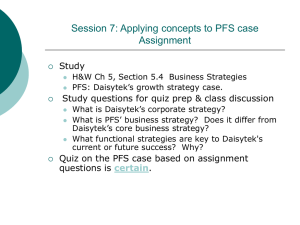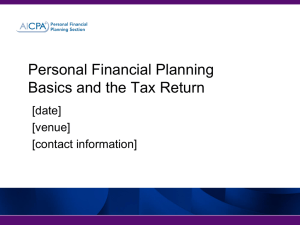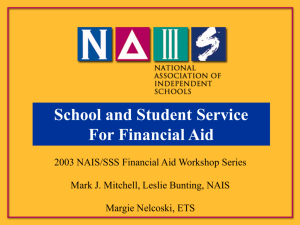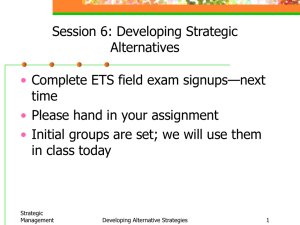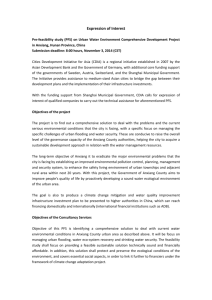County of Los Angeles CHIEF EXECUTIVE OFFICE
advertisement
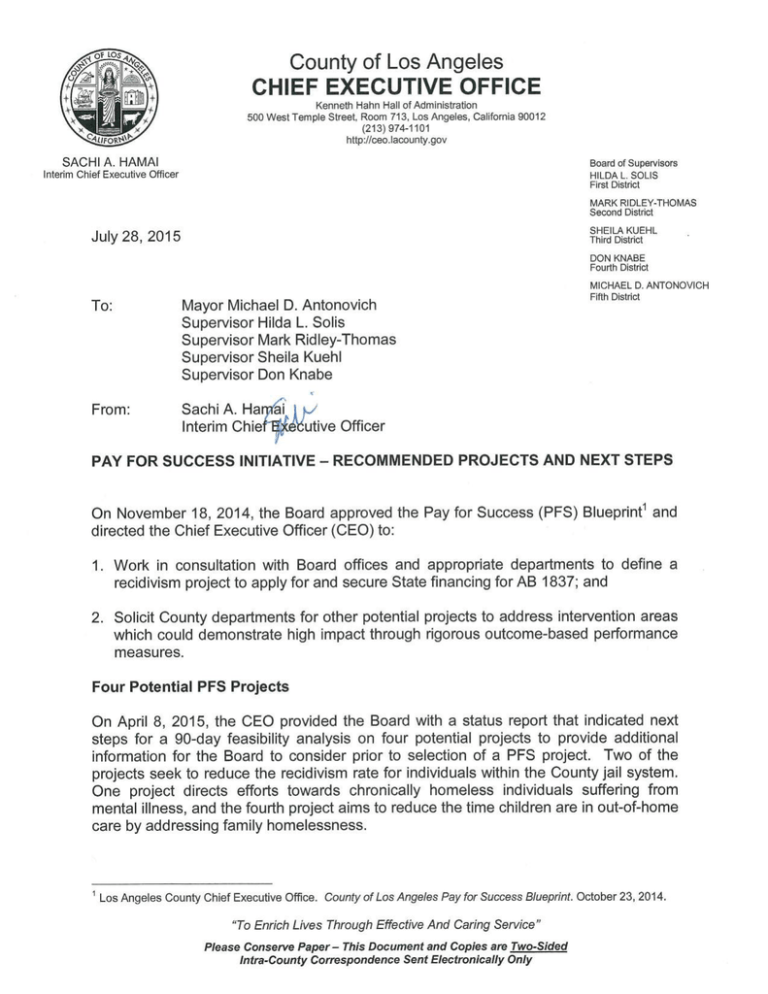
County of Los Angeles CHIEF EXECUTIVE OFFICE Kenneth Hahn Hall of Administration 500 West Temple Street, Room 713, Los Angeles, California 90012 (213) 974-1101 http://ceo.lacounty.gov SACHI A. HAMAI Interim Chief Executive Officer Board of Supervisors HILDA L. SOLIS First District MARK RIDLEY-THOMAS Second District I I ~iUiy 0 U, ~ SHEILAKUEHL Third District ~ DON KNABE Fourth District To: Mayor Michael D. Antonovich Supervisor Hilda L. Solis Supervisor Mark Ridley-Thomas Supervisor Sheila Kuehl Supervisor Don Knabe From: Sachi A. Ha ‘ai Interim Chie MICHAEL D. ANTONOVICH Fifth District utive Officer PAY FOR SUCCESS INITIATIVE — RECOMMENDED PROJECTS AND NEXT STEPS On November 18, 2014, the Board approved the Pay for Success (PFS) Blueprint1 and directed the Chief Executive Officer (CEO) to: 1. Work in consultation with Board offices and appropriate departments to define a recidivism project to apply for and secure State financing for AB 1837; and 2. Solicit County departments for other potential projects to address intervention areas which could demonstrate high impact through rigorous outcome-based performance measures. Four Potential PFS Projects On April 8, 2015, the CEO provided the Board with a status report that indicated next steps for a 90-day feasibility analysis on four potential projects to provide additional information for the Board to consider prior to selection of a PFS project. Two of the projects seek to reduce the recidivism rate for individuals within the County jail system. One project directs efforts towards chronically homeless individuals suffering from mental illness, and the fourth project aims to reduce the time children are in out-of-home care by addressing family homelessness. 1 Los Angeles County Chief Executive Office. County of Los Angeles Pay for Success Blueprint. October 23, 2014. “To Enrich Lives Through Effective And Caring Service” Please Conserve Paper This Document and Copies are Two-Sided — Intra-County Correspondence Sent Electronically Only Each Supervisor July 28, 2015 Page 2 The status report stated that the County’s PFS Committee and Third Sector Capital Partners (TSCP) would return to the Board to provide the following recommendations included in this Board memo and the attached report. 1. A ranking of four projects and recommendations for project selection; 2. A plan for setting up the solicitation process; and 3. Options for financing the success payments, if the project is successful. AB 1837 To address the Board’s directive to define a recidivism project for AB 1837, the CEO has been reviewing information released from the State. On April 9, 2015, the California Board of State and Community Corrections (BSCC) released a tentative timeline on Request for Proposal activities for AB 1837.2 Governor Brown signed AB 1837 into law on September 29, 2014. This established the Social Innovation Financing Program which authorizes the BSCC, through the Recidivism Reduction Fund, to award grants between $500,000 and $2,000,000 to three counties to enter into a PFS or social innovation financing contract. The total amount of these grants would be limited at $5,000,000. Representative(s) of the CEO attended a workshop by the BSCC on July 23, 2015, receiving additional information on applying for this grant. In addition, the PFS Committee will work with TSCP and the lead department for the project selected by the Board to complete the application by the tentative February 2016 date. PFS Committee The PFS Committee includes departments identified in the October 15, 2013 Board motion that directed the CEO to convene an advisory group to develop the County’s PFS Blueprint, including a thorough review of the critical program criteria and characteristics to be considered when selecting a project. The role and responsibilities of each organization are shown in Table 1. In addition, departmental subject matter experts from the four projects provided information during the feasibility analysis that included details on an intervention model and related evidence in the areas of homelessness, recidivism, child welfare, and mental health. 2 http://www.bscc.ca.gov Each Supervisor July 28, 2015 Page 3 Table 1: County’s Pay for Success Committee Organization Responsibilities Coordinates review and assessment of project applications; Chief Executive Office Serves as County budget subject matter expert County Counsel Ensures compliance with County policies/procedures Auditor-Controller Subject matter expert lead on accounting Internal Services Department Subject matter expert lead on procurement Treasurer and Tax Collector Subject matter expert lead on fiscal and financing matters Subject matter expert providing information on PFS models, Third Sector Capital Partners best practices, and feasibility analysis (Consultant) Feasibility Analysis From April through June 2015, TSCP and the PFS Committee conducted a feasibility analysis on the four projects. This analysis included a questionnaire developed by TSCP to gather additional information on the four projects, including baseline data and describing how project interventions would be implemented and scaled to address the social needs of a target population within the County. The information compiled was then reviewed independently by the PFS Committee members and the TSCP consultants, utilizing a scoring rubric developed by the Internal Services Department (ISD), TSCP, and the CEO. The PFS Committee and TSCP evaluated the questionnaires to identify projects most ready for PFS using the Board approved Informed Averaging methodology.3 The assessments revealed that the four projects’ total scores are near or at a high level of readiness for PFS with the Just in Reach project ranked highest (see Table 2). The strengths of projects and any gap related to PFS readiness are summarized in the attached report. Table 2: Ranking of Four Potential PFS Projects Rank Project Lead Department I Just in Reach (Reentry Planning) Sheriff 2 Women’s Reentry Program Public Health Primary Issue Areas Recidivism, Homelessness Recidivism, Substance Abuse, Homelessness ~ Homeless Families Coming Home Together Housing First Project Children and Family Services Mental Health Homelessness, Family Reunification Homelessness, Mental Illness 4 Board pokcy 5.045 Each Supervisor July 28, 2015 Page 4 This report consists of the following three sections: • Section I: Ranking and Assessment of Four Projects Presents the methodology, ranking of projects, and the strengths and gaps of projects based upon key assessment areas that the PFS Committee considered in selection of a PFS project; • Section Il: Plan for Procurement Following the Board’s selection of a PFS project, this section identifies the next steps required for the County to solicit an evaluator, project manager, and service provider; and • Section III: Options for Financing Success Payments Reviews options for financing success payments and steps required prior to launching a PFS project; highlights models used in other jurisdictions that have already launched such projects. — — — Based on the findings included in this report, we recommend that the Board: 1) select the Just in Reach project as the first project for the County to pursue in the PFS context; 2) approve the attached plan to procure the most qualified evaluator, project manager, and service provider(s) for the selected project; and 3) direct the CEO to identify funding for potential success payments for the selected project, to include prospective AB 1837 monies and other sources. It is important to note that the costs to implement the selected project will be identified during the next phase, project construction, as additional factors are further defined, such as project enhancements and scalability. If you have questions, or need additional information please contact Cheri Thomas at (213) 974-1326, or at cthomas~ceo.lacounty.gov. SAH:JJ:CT VD: ljp Attachment (1) C: Executive Office, Board of Supervisors County Counsel Auditor-Controller Children and Family Services Internal Services Department Mental Health Public Health Sheriff Treasurer and Tax Collector PFS Project Recommendations.bm Attachment I COUNTY OF LOS ANGELES PAY FOR SUCCESS INITIATIVE Recommendations for Selection and Construction of a PFS Project July2015 OFLOS~4~ C) * + k 4 + * Pay for Success Project Recommendations CONTENTS Executive Summary 3 Background 4 I. 5 Ranking and Assessment of Four Projects II. Plan for Procurement 7 Ill. Options for Financing Success Payments 8 Summary of Recommendations 9 Appendix 10 Summary of the Four Potential Projects 11 County of Los Angeles 2 Pay for Success Project Recommendations EXECUTIVE SUMMARY The Chief Executive Office’s (CEO) April 8, 2015, report identified criteria for evaluation of potential projects to be considered by the Board of Supervisors for selection of the County’s first PFS project. Figure 1 depicts these six criteria that formed the basis for assessing each project’s readiness for PFS. From April through June 2015, the PFS Committee worked with Third Sector Capital Partners (TSCP) to conduct a 90-day feasibility assessment on four projects (see Appendix for description of projects). The PFS Committee and TSCP evaluated the projects based on information gathered from a questionnaire developed by TSCP. The Board approved Informed Averaging methodology4 was used for the evaluation process. Fig. 1 WellPROGRAM FEATURES Issue or Need Defined Population ____________ PFS Scalability FINANCIAL BENEF READINESS ASSESSMENT CRITERIA Potential Cost Benefit strong InterventIon Model Clear, Measurable Outcomes EVIDENCE ASE Overall, the total scores for all four projects indicated a moderate/high or high level of readiness for PFS, with the Just in Reach project scoring highest (Table 1). This report highlights the strengths and gaps of the projects; a plan for procurement once a project is selected by the Board; and options for financing success payments. The PFS Committee recommends that the Board: 1. Select the Just in Reach project to prepare for launch as the County’s first PFS project; 2. Approve the plan for procurement to select an evaluator, project manager, and service provider(s); 3. Commit to providing formal end-payer support for anticipated success payments by directing the CEO to identify funding for potential success payments for the selected project, to include AB 1837 and other sources. If a recidivism project is selected by the Board, the CEO will work with the lead department to submit an application to the State for the AB 1837 grant by the tentative February 2016 date. Table 1: Ranking of Four Potential PFS Projects Rank Project Lead Department 1 Just in Reach (Reentiy~Planning) Sheriff 2 Women’s Reentry Program Public Health 3 Homeless Families Coming Home i~pgethër Children and Family Services 4 Housing I~irst Proj~ct~ . ~ -- . “ Mental Health Primary Issue Areas Recidivism, Homelessness Recidivism, Substance Abuse, Homelessness Homelessness, Family Reunification Homelessness, Mental Illness Board policy 5.045 County of Los Angeles 3 Pay for Success Project Recommendations BACKGROUND The April 8, 2015, report presented an overview of a PFS timeline consisting of three phases. The 90-day feasibility analysis provides information to the Board for the first phase, Project Selection. The ranking and assessment of the four potential projects is presented in Section I of this report. Upon selection of a project by the Board, the County would enter the Project Construction phase. Sections II and Ill of this report include a plan for procurement of the project manager and service provider(s) as well as options for financing success payments. It is important to note that with any PFS project, unforeseen developments during the construction phase may affect the timing, scale, scope, and feasibility of a project. County PFS Initiative Timeline I. Selection (4 months) • Applications submitted by departments • Application Vetting by PFS Committee • Detailed Feasibility/Gap Analysis (90 days) II. Construction (9-18 months) • Board selects project • Procure evaluator, project manager, service provider(s) • Finance III. Launch (3-7 years) • Intervention • Evaluation • Pay for successful outcomes I. ASSESSMENT OF PROJECTS Upon identification of four potential projects in April 2015, the TSCP and PFS Committee conducted a 90-day feasibility analysis to further assess and rank each project’s readiness for PFS. During May 2015, the TSCP and CEO met with departments from the four projects to: request additional information; provide an opportunity for departments to ask questions; and review the PFS model to clarify the importance of baseline data and a referral pathway. During the meetings with departments in May 2015, a project questionnaire developed by TSCP was distributed to gather information. The Internal Services Department (ISD), in collaboration with TSCP and CEO, developed the PFS Project Evaluation Rubric to scale whether project areas demonstrated a high, moderate, or basic level of readiness for PFS. The Informed Averaging Methodology5 was used to score and evaluate the four questionnaires received from the departments in six areas (Table 2). This methodology is an established County standard that builds upon the preliminary assessment included in the April 8, 2015 report. Table 2: PFS Project Evaluation Rubric 1. Target Population: Determine level of understanding of the target population’s characteristics, size, and existing service utilization. 2. Unmet Need of Target Population (Issue): Assess level of understanding about target population’s unmet need and available baseline data. 3. Intervention Scalability: Assess plan and referral pathway to ensure a sufficient number of participants enter the program; review pilot project. 4. Intervention Model (Solution): Review description of intervention model and evidence to show connection with outcomes; assess understanding of potential service providers. 5. Measurable Outcomes: Evaluate the identification and development of intended outcomes, and the accessible data systems. 6. Potential Cost Benefit/Savings: Evaluate potential cost of the scaled intervention, economic benefits and other non-financial benefits to the County. Board policy 5.045 County of Los Angeles 4 Pay for Success Project Recommendations Findings Based upon the assessment areas described, the PFS Committee focused on identifying application(s) that were most ready for the PFS framework. Table 1, as listed on page 3, shows the ranking of the projects. Key findings indicate: All projects’ average total scores are at or near a high level of readiness. • Table 3 summarizes the average ratings by assessment area for the projects. On average, all projects received either a high or moderate score in all areas. For each project, the scores for the six assessment areas are shown. A moderate score for a specific area indicates that some gaps exist. Evaluators based their rating on their understanding and the clarity of information received by the department. The Just in Reach project has the highest average score. Table 3: Average PFS Readiness Ratings by Assessment Area Area Target Population Just in Reacl~’ Individuals in County jail with mental illness Issue Recidivism ~ W~r~e~n’s R~entry • High-risk women in County jail needing complex treatment • 73% recidivism rate; over 80% homeless Other Issue HômeI~s Families Housin~First • Homeless parents • Most vulnerable, without physical chronically custody of children homeless with mental illness Highest utilizers of • No public assistance County services to maintain (“‘$3,000/month)7 housing; housing is • 58% recidivism rate (female prisoners with drug offense)6 barrier to reunify Population. Need Intervention Scalability Outcomes. Cost/Benefit ***High rating; 6 ** ~ ~.-‘ :‘ ‘.~ ~_*•**~~. ~. ~. .~.. ‘.z. **~* ~ . i..~.; - ~“ ~ ,~ _**a ~ ** ** ~ ~ I . - ** . ,.‘ ~ .~ ~.- ** - I - ~ - ** Moderate rating. Moderate rating indicates gaps exist. Derose MR, Cooper AD, Snyder HN. Recidivism of prisoners released in 30 states in 2005: Patterns from 20052010. Washington, DC: U.S. Department of Justice; 2014. ~ Where We Sleep: Costs when homeless and housed in LosAngeles. Economic Roundtable; 2009. County of Los Ange’es 5 Pay for Success Project Recommendations Table 4 provides an overview of key strengths and remaining gaps that programs would need to address in order to be prepared for launch as a PFS project. Table 4: Preparing for PFS: Strengths and Gaps by Project Project :Str~ngti~s : Just in eac Women’s Reentry Homeless Families a) z Well d~fined population characteristics Cl~a~uflde.rsfaridin~àf~population’s needs. ~ ‘Descnptive~intervention model. ~ E~idei~ceshoWS decrease in recidivism. • De~ri~tcve, detailed~intervention model E~,idencéshows decrease in recidivism. r. i • ~Solid understanding ofaccessible data systems and available data. ~• :‘. . Gaps • Housing component requires further analysis. • Intervention operating model will need to be adjusted to accommodate increased scale and role of a new provider. • Housing component requires further analysis. • More program data on long-term substance use and associated costs. Clearly defined outcome to decrease number of days in foster care by reunifying children with their parents. • Developing referral pathway and identifying role of service provider to scale project. • More baseline data to define target population’s need for housing (permanent, rapid re-housing) and supportive services. • Evidence from pilot to demonstrate outcomes. • Evidence-based, Housing First model. • Solid understanding of accessible data systems and available data. • Study indicates long-term decrease in service utilization, cost avoidance to County.8 • Plan to ensure high risk population will enter and stay in program. • Proposal did not indicate an estimated scale of the program (total addressable population). • 1.. ~ Housing First 8 Ibid. County of Los Angeles 6 Pay for Success Project Recommendations II. PLAN FOR PROCUREMENT To gather all information needed to select the most qualified service provider(s), the team (lead department, evaluator, TSCP, and CEO) will conduct a complete feasibility assessment to refine the target population, design the complete intervention operational pathway, develop a preliminary economic model, and cond uct research/inventory on existing resources. Once the Board selects a project, the PFS Committee, TSCP and CEO will work to develop procurement processes to select an evaluator and project manager. With the evaluator, the CEO and TSCP will work with the lead department to: 1. Further refine the features of the target population and their current service usage; 2. Identify data elements and the frequency for data collection along the referral and operational pathway; 3. Determine which outcomes will be monitored to ultimately calculate potential success payments; and 4. Identify data systems and related requirements for operations and reporting. During the complete advanced feasibility, the team will work with the service provider community to determine the anticipated cost from start-up to at-scale, the anticipated service provider budget and capital needs, and other financial resource needs (i.e., housing cost, etc.). While the complete feasibility work occurs over a few months, the County lead department will work on developing a procurement process to solicit and select the service provider(s). At the end of this phase in the fourth quarter, the County would select the service provider(s). Moreover, the selected project manager will work with the team to produce a detailed process flow chart for the intervention operations, showing the complete path for clients from identification, eligibility/selection, program participation, and evaluation periods. Additionally, the County would work with the team and evaluator to provide data on the target population’s actual service utilization and associated costs using accessible data systems. Following the selection of the project manager and identification of the service provider(s), the project team and the County would approach private and philanthropic organizations to secure upfront funding for project launch. Table 5: FY 2015-16 Plan for County PFS Initiative Construction Phase Goal Milestone 1. Select Project(s) • Board of Supervisors selects project(s) 2. Select Evaluator and • Develop procurement processes; issue solicitation Project Manager • Select evaluator and project manager 3. Complete Advanced • Refine target population; Build-out intervention operational pathway • Develop preliminary economic model; conduct inventory/research Feasibility Assessment • Define service provider landscape 4. Select Service Provider • Design service provider procurement process; Issue solicitation • Select service provider(s) • Conduct initial PFS end-payer discussions 5. Funding, Preparation, and • Prepare and submit AB 1837 response (if recidivism project) Next Steps • Soft outreach to funders who may be interested in the project • Project Construction and Planning (work plan) — County of Los Angeles Quarter 1 1-2 2 1-3 1 2-4 2-4 1-3 4 4 7 Pay for Success Project Recommendations III. OPTIONS FOR FINANCING SUCCESS PAYMENTS Three examples of PFS appropriation from jurisdictions that have already launched PFS projects are shown in Table 6. In these examples of government PFS appropriation, the source of the funding may vary; however, a common theme is that the government entity makes a commitment that funding for success payments will be available, if outcomes are attained. Similarly, prior to receiving support from funders, the PFS Committee recommends that the Board direct the CEO to identify funding for potential success payments for the selected project, to include prospective AB 1837 monies and other sources. In reviewing other jurisdictions that have launched a PFS project, the government entity typically makes a commitment to funders by appropriating funds prior to contract negotiation. Private and philanthropic funders that provide upfront funding for the program’s service delivery and operations want assurance that success payments will be available when desired outcomes are indicated. Funders often request that a timeline be included during the construction period, if a method of appropriation must be created through legal or regulatory action. - Table 6: Examples of Jurisdictions’ PFS Appropriations for Success Payments Commonwealth~of Characteristic , ~Cuyahoga County, Ohio Massa~husetts - Social Impact Financing Fund: Leverages private investment in County’s social service systems; subsidized through County’s Health and Human Service Levy proceeds. Sinking Fund: An annual Method of~ Apprópriatiàn appropriation is made each fiscal year in the amount equal to the expected payments based upon the service provided during the fiscal year. ~G~vernrnent’s Contracts longer than Cornrñitment•~ ‘ County’s budget cycle are subject to County’s annual appropriation process. Fiscal Officer annually encumbers A the portion of the contract funds through the next year of the contract. ~Soc~of~’ - •~Funding~ - -~. - ~ New-York State ~ Commonwealth Social Innovation Fund (SIF); Department of Labor grant U.S. Department of Labor federal grant (Phase I); NYS PFS Contingency Reserve (Phase II) Sinking Fund: An annual appropriation is made each fiscal year in the amount equal to the expected payments based upon the service provided during the fiscal year. The ultimate success payments from the sinking fund are backed by full faith and credit pledged by the Commonwealth, through their legislation. State annual appropriations. For instance, during the 2013-14 State budget, $30 million for a PFS Contingency Reserve for use from April 1, 2013 to March 31, 2015. Intermediary Agreement outlines that Federal grant funds success payments for Phase I and state annual appropriations fund success payments for Phase II. NYS Dept. of Labor will “use its reasonable efforts to obtain legislative approval for sufficient Appropriations to make the Outcome Payments required to be paid”. Source: Third Sector Capital Partners County of Los Angeles 8 Summary of Recommendations and Next Steps This report provides three recommendations for the Board’s consideration. 1. Select the Just in Reach project by the Sheriffs Department to be the first PFS project that the County launches. Based on the PFS Committee’s assessment with TSCP, the Just in Reach project shows the most readiness for PFS. In addition, with the AB 1837 application process forthcoming, the state’s Social Innovation Financing Program is a potential source of funding for a PFS project focused on decreasing recidivism. 2. Approve the plan to begin the procurement process, as indicated herein, to solicit the most qualified evaluator, project manager, and service provider(s) for the selected project. 3. Direct the CEO to identify funding for potential success payments for the selected project, to include prospective AB 1837 monies and other sources. Once the Board selects a project for PFS, approves a plan to begin the next phase, and directs the CEO to set up a designated fund for future success payments, the County CEO and PFS Committee will continue to work with the lead department and TSCP to implement the County’s plan during the project construction and launch phases. During project construction, the CEO will update the Board periodically to notify of progress toward structuring the project for launch. Appendix 10 Summary of Four Potential Projects for PFS Recidivism Project Just in Reach — — Sheriff’s Department A well-defined target population Homeless, repeat offenders (three times in past three years) who are incarcerated and sentenced individuals in the Los Angeles County jail system and are expected to be discharged from jail in 30-120 days. Participants have a diagnosable substance use disorder, serious mental illness, posttraumatic stress disorder, developmental disability, cognitive impairments resulting from a brain injury, or chronic physical disability including the co-occurrence of two or more of those conditions. The participant should have been homeless continuously for at least one year or on at least on four separate occasions in the last three years. An assessment tool would be used to identify participants. — Clearly defined issue or need The mentally ill population has the highest recidivism rate of any offender group (70-73% return rate to custody within three years). — Scalability and potential impact The Sheriff’s Department estimates 3,500 individuals in the County jail system are in need of mental health services. — Strong intervention model A pilot project connecting individuals with community providers and supportive services prior to release has shown to reduce the recidivism rate of participants. In addition, with the provision on permanent housing, the model would support housing retention in safe, stable housing. — Clear, measurable outcomes The 2010-11 recidivism rate (rearrested) was 41% for participant and 76% for the general population. — Potential cost benefit/savings to public sector Annual cost of incarceration per individual is $78,348/year compared to the program cost of $3,740/year.9 Potential areas for cost avoidance include health care system costs (ER visits, hospitalizations). Other areas for cost avoidance should be investigated. — Recidivism Project Women’s Re-entry Court DPH — — A well-defined target population Women with histories of substance use disorder who have been charged with a felony offense, or have a probation violation while on probation for a felony offense. This population of women in the criminal justice system often faces mental health illness and trauma histories, in addition to substance use disorders. The County estimates 15,432 women in the target population, with 82% having history for a substance use disorder. — A national Bureau of Justice Assistance multi-site study of women in jails demonstrates high rates of mental health problems, with the majority of women meeting criteria for serious mental illness (43%) and posttraumatic stress disorder (PTSD) (53%). The study also indicates that 56% of women have children under age 18.10 9This cost does not account for the cost of supportive housing that may be offered to clients. 10 Lynch 5, DeHart D, Belknap i, Green BL. Women’s Pathways to Jail: The roles and intersections of serious mental illness and trauma. Supported by the Bureau of Justice Assistance. 2012. 11 Estimated Tar~et Popula3ion in Los ~ngeIe~ County TargetPopulation Women charged with non-violent, non-serious, non-sex offenses Women charged with serious or violent crime Women on probation for a felony offense who have a probation violation 11,041 3,530 861 Total 15,432 Currently, women in Los Angeles County jail are screened for mental health illness and referred to services, yet these services are not integrated with substance abuse treatment to address co-occurring disorders. Integrated treatment services and drug treatment options for high-risk women are lacking in the County jail system. Continuing and/or expanding this program would address this gap in integrated treatment to meet the health and wellness needs of incarcerated women with co-occurring disorders. Clearly defined issue or need — Scalability and potential impact A comprehensive assessment determines level of care for substance abuse and mental health issues. With 82% of women in the target population with a history of substance use disorder, there is potential to serve more women. — Specialized court-based jail diversion program provides mental health and substance use disorder treatment along with housing, employment, and family reunification services. The women have a minimum of six months residential treatment, 6-12 months of outpatient treatment, and six months of aftercare. Strong intervention model — Clear, measurable outcomes— Women who graduated from the program in FY 2011-12 had a three- year recidivism rate (new felony convictions) of 18%, which is significantly lower than the 49% rate for women who were released from state prison in 2009-2009. Furthermore, participants experienced a 54% decrease in homelessness, a 10-fold increase in employment rate, decrease in substance use, and mental health improvement (1/5 as likely to be diagnosed with PTSD).11 Potential cost benefit/savings to public sector Daily cost of residential treatment and incarceration are similar, however, residential treatment will likely result in long-term cost savings due to its impact on lowering recidivism. Long-term cost savings are estimated to be at least $800,000 per year (post-release). — Homeless Families Coming Home Together DCFS — A well-defined target population According to the Department of Children and Family Services, over 20,000 children are currently in out-of-home care (OHC). — Clearly defined issue or need A homeless parent without physical custody of his/her child is not eligible to receive any public assistance to maintain suitable housing. If parents received housing assistance, their children would spend fewer days in OHC. This project would focus on assisting families with children in OHC that DCFS has identified homelessness being the sole barrier to reunification of the family. — 11ButIer K, Pourshaban D, Basurto-Davila R, Shih M. The Potential Benefits and Costs of Sustaining a Women’s Jail Diversion Program for Women with Felony Charges in Los Angeles County. Rapid Health Impact Assessment. Los Angeles County Department of Public Health, Health Impact Evaluation Center. March 2015. 12 Scalability and potential impact Research has shown that 62% of women who have ever been homeless have had their children in foster care, compared to 39% of a low-income comparison group cohort.’2 — Strong intervention model The project would provide financial assistance and supportive services to assist families in securing and retaining permanent housing so that children can be reunited with their parents more expeditiously. The Homeless Family Solution Center (HFSS) would coordinate homeless services for the family to identify whether rapid re-housing, transitional housing, or supportive housing is needed. — Clear, measurable outcomes Number of days that children with homeless parents spend in foster care will decrease; Housing retention of families after 12 months will increase; and the number of children who suffer subsequent maltreatment in the year following return home will be low. — Potential cost benefit/savings to public sector Decreasing the number of days that children are in OHC has potential cost avoidance for the County. The overall impact on children and their families would be measured. — Housing First Project DMH — A well-defined target population Based on the Los Angeles Homeless Services Authority 2013 homeless count, there are 13,613 chronically homeless individuals on any given night. Of the individuals experiencing chronic homelessness approximately 50% or 6,800 also have a mental illness. — Clearly defined issue or need —Those who are chronically homeless often have co-occurring mental health, physical health and substance use disorders and other serious barriers that prevent them from transitioning from the streets to a home. They also tend to be high users of publically funded health and criminal justice resources. Despite all of the progress that has been made to end homelessness in Los Angeles using a Housing First approach, more resources are needed to accomplish these goals. Scalability and potential impact The County’s Project 50 and replica projects have served the most vulnerable, chronically homeless individuals as determined by a common assessment tool to identify the most at risk of serious injury, illness and death. In addition, an outreach and engagement team referred the most vulnerable to the program. — Strong intervention model —The nationally recognized approach to ending homelessness is Housing First. Housing First is an evidence-based practice that recognizes that individuals are more likely to recover from mental illness, chronic physical health problems and/or substance use disorders if they have a permanent home and; therefore, focuses on providing people who are homeless with permanent housing first and then services as needed and requested. 12Culhane iF et al. Prevalence of child welfare services involvement among homeless and low-income mothers: A five-year birth cohort study, Journal of Sociology and Social Welfare, 2003, 30, 79-95. 13 Clear, measurable outcomes A study by the County’s CEO Service Integration Branch has shown both the cost effectiveness and positive social impact of Project 50. The study showed a significant decrease in ER visits, hospitalizations, and incarceration for participants.13 — Potential cost benefit/savings to public sector There have been multi-year studies that demonstrate cost savings to systems through the Housing First intervention for successive years. — 13Moreno M, Toros H, Stevens M. Project 50: The Cost-Effectiveness of the Permanent Supportive Housing Model in the Skid Row Section of Los Angeles County. County of Los Angeles, Chief Executive Office. June 2012. 14

